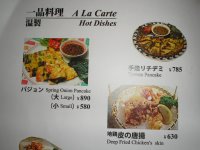 Among my favorite Korean dishes is 파전 (p’ajŏn, pajeon), which usually shows up on North American menus as Pa Jun. In North America, it's often compared to pizza, and in Japan to okonomiyaki. But Jun refers to a much thinner egg batter for quick pan-frying than the batter used in either pizza or okonomiyaki. (In Hawai‘i and parts of the West Coast, you can also find meat jun.)
Among my favorite Korean dishes is 파전 (p’ajŏn, pajeon), which usually shows up on North American menus as Pa Jun. In North America, it's often compared to pizza, and in Japan to okonomiyaki. But Jun refers to a much thinner egg batter for quick pan-frying than the batter used in either pizza or okonomiyaki. (In Hawai‘i and parts of the West Coast, you can also find meat jun.)Japanese Wikipedia tries to clarify the difference.
日本ではよく、チヂミと「パジョン」(파전)が混同されることがあるが、パジョンとはプチムゲ(慶尚道ではチヂミ)の一種である「ジョン」(전)のうち、ネギ(パ、파)を使用したものである。「ジョン」にはこのほか、キムチを使用した「キムチジョン」(김치전)、ジャガイモを使用した「カムジャジョン」(감자전)、海産物を使用した「ヘムルジョン」(해물전)などがある。My rough translation follows (as amended by Matt of No-Sword), using Japanese ro
In Japan, chijimi and pajon (파전) are often confused, but pajon is actually jon (전) that uses green onions (pa, 파). Jon, in turn, is a type of puchimuge (called chijimi in Kyongsang Province). There are other types of jon that use kimchee (kimuchijon, 김치전), potato (kamujajon, 감자전), or seafood (hemurujon, 해물전).While doing a bit of nostalgia-driven culinary fieldwork near the Sannomiya area of Kobe (where I went to high school), I chanced upon a menu that listed both pajon and chijimi side by side (pictured above). So I sampled a small order of pajon to go with a glass of Taishikan Weizen at the Tor Road branch of the New Muenchen Kobe Taishikan, a beer hall whose ambience I fondly remembered, but whose location had drifted away from me (unless it was rebuilt in a different location after the Great Hanshin Earthquake of 1995).
My research results seem to indicate that Kyongsang-style chijimi more closely resembles Osaka-style Japanese okonomiyaki than does pajon, because that style of chijimi has both a thicker batter and a milder dipping sauce. If chijimi is ever served with mayonnaise, well, that would add an even more decisive factor. The essential difference seems to lie in the batter. Jon uses a lighter egg batter for quick frying, while chijimi uses a heavier batter thickened with more flour. The チヂミ粉 'chijimi flour' that you can buy in Japanese supermarkets apparently contains bean flour as a thickener.
PS: In my careful scrutiny of the New Muenchen Tor Road menu, I noticed a few odd transcriptions out of Japanese katakana into something other than German, Italian, or English: waizen beer, focatcha bread, and humberger sandwich. Being the roving editorial dogooder that I am, I wrote out a note for the management listing the oddities and suggesting corrections. The Japanese spellings in my note were no less idiosyncratic than the romanized spellings on the menu, but I hope the management at least will get a second opinion on the items I noted. (The menu at the main brewpub was much more accurate. It also featured beer-flavored ice cream, which was fortunately beyond the scope of my fieldwork agenda.)
eGullet Forum has a pertinent discussion thread on Korean food in Japan. Some commenters clearly regard Chijimi as just a dialectal synonym of Pa Jun.
UPDATE: I've made some revisions in response to corrections by Matt of No-Sword, who was kind enough to be my roving editorial dogooder.
Never pass up beer ice cream. It is surprisingly delicious.
ReplyDeleteI have a simpler answer for you. Chijimi sounds like the Japanese pronunciation of the Korean "튀김이" or "Twe-gim-i," which means deep fried finger foods in Korean. Pajeon is sino-Korean for friend things that have green onions in it. 파전 "Pajeon" or 파煎 where 煎 = Jeon. 파 is native Korean for green onions. Jeon is Sino-Korean for "fried." So, literally Pajeon means fried green onions but in reality means any kind of fried thing that has green onions in it, which would be more jeons.
ReplyDeleteSeems as if the meanings have changed in Japan. What's pajon in Korea is now chijim in Japan. However, what was once "chijim" in Korean has come to mean fried finger foods in Korea.